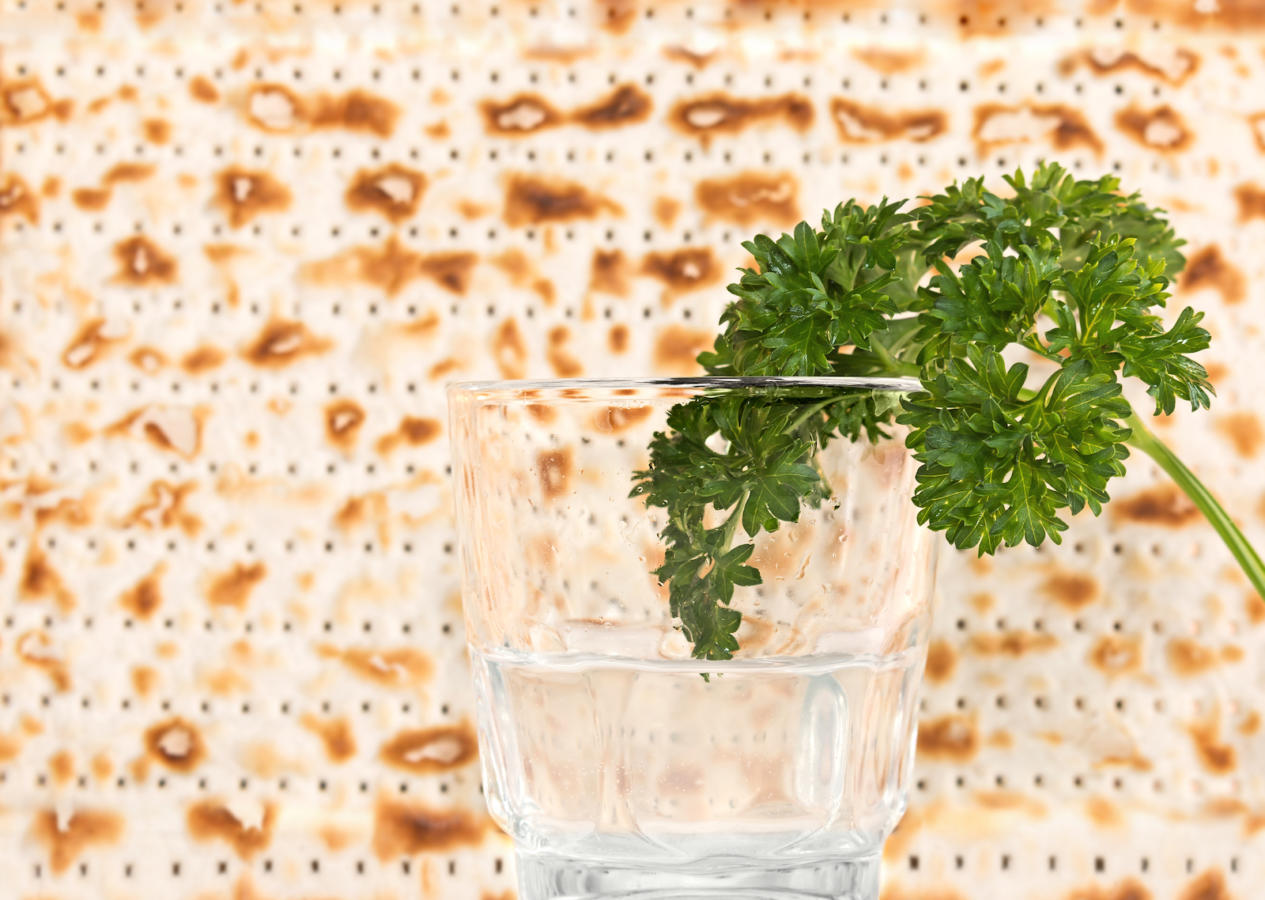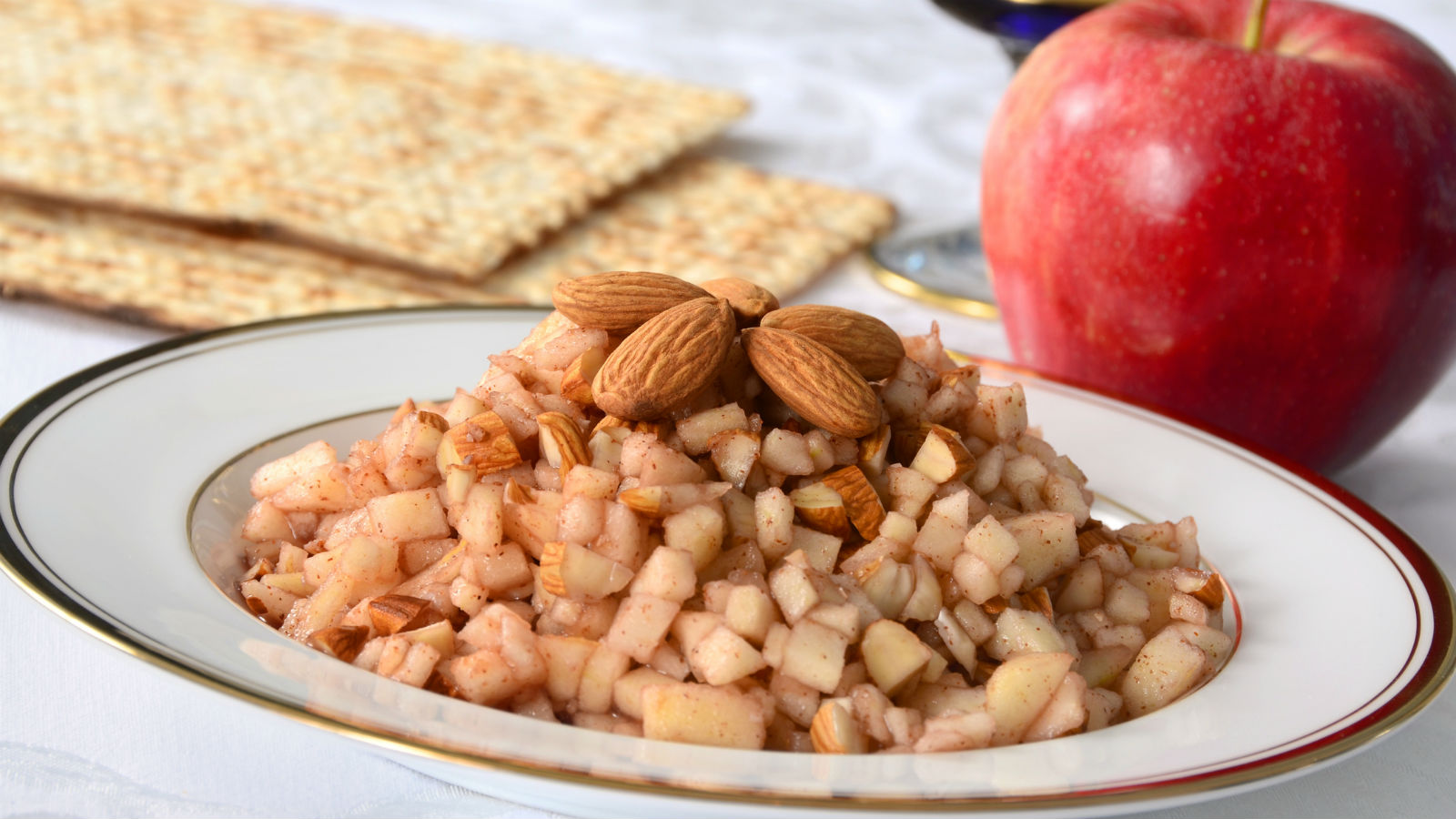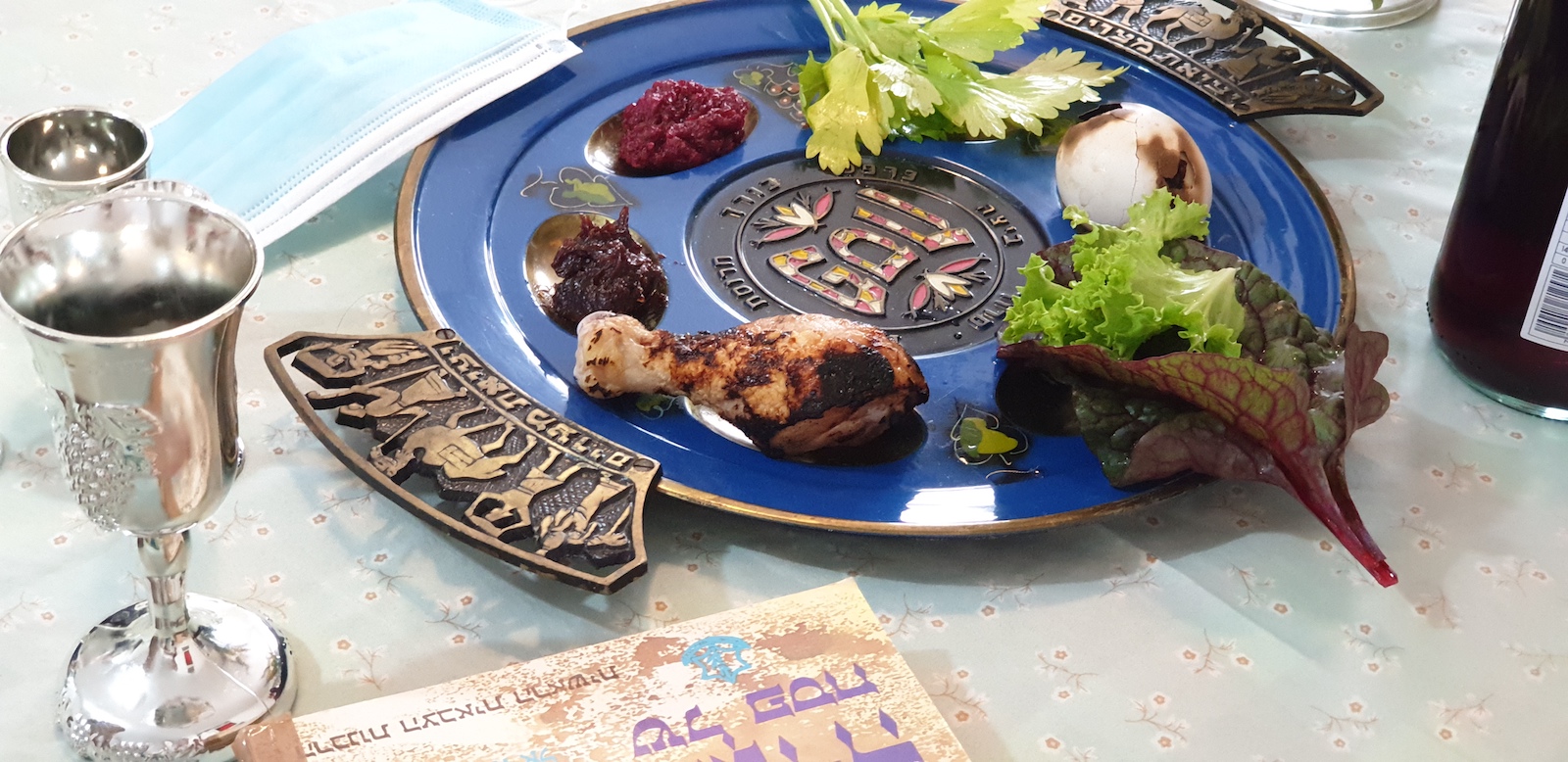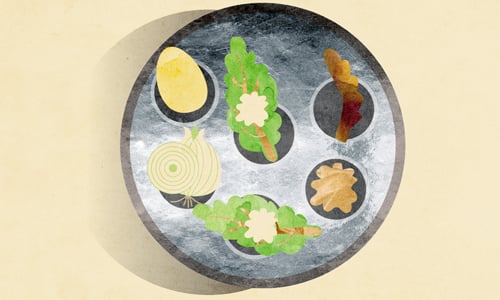The Passover Haggadah demands that each person see him or herself as having personally come forth out of Egypt. Accordingly, the is one of the most sensory-heavy rituals of the Jewish year. During the seder, we don’t just tell the story of the Exodus, we see, smell, feel, and taste liberation.
Many of the elements of this sensory experience appear on the seder plate (k’arah), which serves as the centerpiece of the seder table. The seder plate traditionally holds five or six items, each of which symbolizes a part (or multiple parts) of the Passoverstory.
What’s On the Seder Plate
Karpas (a green vegetable, most often parsley)
Karpas represents the initial flourishing of the Israelites during the first years in Egypt. At the end of the biblical book of Genesis, Joseph moves his family to Egypt, where he becomes the second-in-command to Pharaoh. Protected by Joseph’s exalted status, the family lives safely for several generations and proliferate greatly, becoming a great nation. The size of this growing population frightens the new Pharaoh, who enslaves the Israelites, lest they make war on Egypt. Even under slave conditions, the Israelites continue to reproduce, and Pharaoh eventually decrees that all baby boys be killed. In the course of the seder, we dip the karpas in salt water (Ashkenazi custom) or vinegar (Sephardi custom) in order to taste both the hope of new birth and the tears that the Israelite slaves shed over their condition.

Karpas also symbolizes the new spring. One of the names for Passover is Hag Ha-Aviv or the “holiday of spring.” Right around Passover the first buds emerge, and we look forward to the warmth and sense of possibility that accompany the beginning of spring. Some Jews use a potato for karpas, as green vegetables were not readily available in Eastern Europe.
Haroset (sweet fruit paste symbolizing mortar)

This mix of fruits, wine or honey, and nuts symbolizes the mortar that the Israelite slaves used to construct buildings for Pharaoh. The name itself comes from the Hebrew word cheres or clay. Ashkenazi Jews generally include apples in haroset, a nod to the midrashic tradition that the Israelite women would go into the fields and seduce their husbands under the apple trees, in defiance of the Egyptian attempts to prevent reproduction by separating men and women.
Sephardic recipes for haroset allude to this fertility symbolism by including fruits, such as dates and figs, mentioned in Song of Songs, the biblical book that is most infused with images of love and sexuality.
Maror (bitter herb, often horseradish)

This bitter herb allows us to taste the bitterness of slavery. Today, most Jews use horseradish as maror. Originally, though, maror was probably a bitter lettuce, such as romaine, or a root, such as chicory. Like life in Egypt, these lettuces and roots taste sweet when one first bites into them, but then become bitter as one eats more. We dip maror into haroset in order to associate the bitterness of slavery with the work that caused so much of this bitterness.
Hazeret (second bitter herb, often Romaine lettuce)
A second bitter herb, used in korech or the Hillel sandwich, which consists of matzah and bitter herbs (some add haroset as well). Many Jews use horseradish for maror and Romaine lettuce or another bitter green for hazeret. Others use the same vegetable for both parts of the seder, and do not include hazeret on the seder plate at all.
READ: How To Veganize Your Seder Plate
Zeroa (shank bone)
A roasted lamb shank bone that symbolizes the lamb that Jews sacrificed as the special Passover offering when the Temple stood in Jerusalem. The zeroa does not play an active role in the seder, but serves as a visual reminder of the sacrifice that the Israelites offered immediately before leaving Egypt and that Jews continued to offer until the destruction of the Temple. Vegetarians often substitute a roasted beet, both because the red of the beet resembles the blood of the sacrifice and because the mentions beets as one of the vegetables sometimes dipped during the seder.
Beitzah (egg)
A roasted or hard-boiled egg that symbolizes the hagigah sacrifice, which would be offered on every holiday (including Passover) when the Temple stood. The roundness of the egg also represents the cycle of life — even in the most painful of times, there is always hope for a new beginning.
How Is the Seder Plate Arranged?

There are a few traditions regarding the arrangement of items on the seder plate. Most commonly, the maror is placed in the middle of the plate. The hazeret is at the six o’clock position followed by, moving clockwise, karpas (seven o’clock), beitzah (11 o’clock), z’roa (one o’clock), and haroset (five o’clock).
What Else Is On the Seder Table?
In addition to the items on the seder plate, the seder table should also have three pieces of matzah wrapped or covered in a cloth and a container of salt water or vinegar in which to dip the karpas. Some seder plates have a compartment for matzah underneath, or include space for salt water among the other symbols. In most cases, though, matzah and salt water or vinegar sit near, but not on, the seder plate.
Many contemporary Jews add additional items to the seder plate to symbolize modern liberation struggles. The most common new item is an orange, which honors the role of women and/or gays and lesbians in Jewish life. The orange symbolizes the fruitfulness that these previously marginalized communities bring to Jewish life. Some Jews place an olive on the seder plate to signal hope for eventual peace between Israelis and Palestinians.
READ: 10 Unique Items to Add to Your Seder Plate
One way to encourage participation in the seder is to ask each guest to bring one item that, for him or her, represents liberation. Participants might bring family heirlooms that remind them of their family’s immigration story, newspaper stories about current liberation struggles, or other symbolic objects. Each guest should place this item near the seder plate and, at an appropriate time in the seder, explain its significance.
The Seder plate (Hebrew: ke'arah קְעָרָה) is the focal point of the proceedings on the first (two) night(s) of Passover. Whether it is an ornate silver dish or a humble napkin, it bears the ceremonial foods around which the Seder is based. Here is the order: matzah, the zeroa(shankbone), egg, bitter herbs, charoset paste and karpas vegetable.
Preparing these items requires some time. It is best to prepare all the Sederfoods before the onset of the holiday, in order to avoid halachic questions.
The special foods we eat on Passoverare also food for thought. Every symbolic food on the Seder plateabounds in meaning and allusion. Here you will learn the descriptions of each of the foods, the reason why it is included, the method of preparing it, and its role in the Seder meal.
The 6 Symbolic Foods
- Matzah
- Zeroa (Shankbone)
- Beitzah (Egg)
- Maror and Chazeret (Bitter Herbs)
- Charoset (Paste)
- Karpas (Vegetable)
- Your Finished Seder Plate:
Matzah
Three matzot are placed on top of each other on a plate or napkin, and then covered. (Some also have the custom to separate the matzot from each other with interleaved plates, napkins or the like.)
We have three matzot, so that we can break one (as a slave would), and still have two whole matzot over which to recite the Hamotzi blessing (as required on Shabbat and holidays). The matzot are symbolic of the three groups of Jews: Priests, Levites and Israelites. They also commemorate the three measures of fine flour that Abraham told Sarah to bake into matzah when they were visited by the three angels (Genesis 18:6).
It is ideal to use handmade shmurahmatzah, which has been zealously guarded against moisture from the moment of harvest. You can purchase shmurah matzah here.
On a cloth or plate placed above the three matzot, we place the following items:
Zeroa (Shankbone)
A piece of roasted meat represents the lamb that was the special paschal sacrifice on the eve of the exodus from Egypt, and annually on the afternoon before Passover in the Holy Temple.
Some use a forearm of a lamb. Called the zeroa, it alludes to the verse which states, “I will redeem you with an outstretched arm (zeroa).”
Since we don’t want to appear to offer the paschal sacrifice in the absence of the Holy Temple, others take care to use something that is relatively dissimilar to the actual offering. Accordingly, many communities have the custom to use a roasted chicken neck or the like.
Preparation: Roast the neck on all sides over an open fire on the stove. Afterwards, some have the custom to remove the majority of the meat of the neck (but not all of it).
Role in the Seder: The zeroa is not eaten at the Seder. After the meal it can be refrigerated, and used again on the Seder plate the following night.
Beitzah (Egg)
A hard-boiled egg represents the pre-holiday offering (chagigah) that was brought in the days of the Holy Temple. The meat of this animal constituted the main part of the Passover meal. The Aramaic word for “egg” is bei’ah, which is similar to the Aramaic word for “desire,” expressing that this was the night when G‑d desired to redeem us.
Preparation: Boil one egg per Seder plate, and possibly more for use during the meal.
Role in the Seder: Place one egg on the plate. As soon as the actual meal is about to begin, remove the egg from the Seder plate and use during the meal.
A popular custom is to eat these eggs together with the saltwater which was set on the table.
Maror and Chazeret (Bitter Herbs)
Bitter herbs (maror) remind us of the bitterness of the slavery of our forefathers in Egypt. Fresh grated horseradish, and romaine lettuce (or endives), are the most common choices.
The leaves of romaine lettuce are not bitter; but the stem, when left to grow in the ground, turns hard and bitter. So it was with our enslavement in Egypt. At first the deceitful approach of Pharaoh was soft and sensible, and the work was done voluntarily and even for pay. Gradually it evolved into forced and cruel labor.
Preparation: Peel the raw horseradish roots, rinse and dry well.
Next, grate the horseradish with a hand grater or food processor. (This must be done before the holiday begins.) Whoever will be grating the horseradish may begin to shed copious tears or cough a lot. Shielding the mouth and nose with a cloth may help. No beets or other condiments should be added to the horseradish.
Romaine lettuce is often very sandy. Wash each of the leaves separately, checking very carefully for insects. Take care that they do not soak for 24 hours. (Those who are particular not to eat matzah that becomes moist should pat the lettuce gently with a towel and let it sit until completely dry, so that there will be no moisture to come in contact with the matzah.)
Depending on how much romaine lettuce is needed, it can take several hours to prepare. This task should be completed before candle-lighting time on the first night. Prepare enough leaves for both nights, and store in the refrigerator.
Romaine is preferred over horseradish, and many have the custom to use both kinds together. Place a few cleaned, dried leaves of romaine lettuce on the Seder plate, topped with the horseradish. Since this will be used twice, it actually takes two spots on the Seder plate. The top pile (in the center of the plate) is called maror (bitter herbs), while the pile that sits beneath it is referred to as chazeret (lettuce).
Role in the Seder: After the recital of most of the Haggadah comes the ritual handwashing. Then matzah is eaten, followed by some maror (taken from the maror pile), followed in turn by a sandwich of matzah and maror (this time taken from the chazeret pile).
Charoset (Paste)
A mixture of apples, pears, nuts and wine, which resembles the mortar and brick made by the Jews when they toiled for Pharaoh.
Preparation: Shell nuts and peel apples and pears, and chop finely. Mix together and add a small amount of wine.
Role in the Seder: This is used as a type of relish, into which the maror is dipped (and then shaken off) before eating.
Karpas (Vegetable)
Many have the custom to use parsley, called karpas in Hebrew. This vegetable alludes to the backbreaking work of the Jews as slaves, as the Hebrew letters of karpas can be arranged to spell the word perech plus the letter samech. Perech means backbreaking work, and samech is numerically equivalent to 60, referring to 60 myriads, equaling 600,000, which was the number of Jewish males over 20 years of age who were enslaved in Egypt.
Preparation: Prepare your vegetable, an onion or (boiled) potato in many Eastern European traditions. Cut off a slice and place on Seder plate. On the table, next to the Seder plate, place a small bowl of saltwater.
Role in the Seder: After recital of kiddush, the family goes to the sink and ritually washes their hands, but without saying the usual blessing.
Everyone then takes a very small piece of the vegetable and dips it in saltwater. After the appropriate blessing is said, the karpas is eaten. Care should be taken that each person eats less than 17 grams (about ½ ounce).
Your Finished Seder Plate:

Now that you’ve gotten your Seder plate down pat, here are some other Seder essentials for you:
- Browse a selection of seder plates
- Print (or study) the Haggadah
- Read the Passover story in short
- Review the Seder service in a nutshell
Or watch this inspirational video to get you into the freedom-filled Passover spirit:
Many reasons are given for drinking four cups of wine. Here are some of them:
When promising to deliver the Jews from Egyptian slavery, G‑d used four terms to describe the redemption (Exodus 6:6-8): a) "I shall take you out..." b) "I shall rescue you..." c) "I shall redeem you..." d) "I shall bringyou..."
The four cups symbolize our freedom from our four exilesWe were liberated from Pharaoh's four evil decrees: a) Slavery. b) The ordered murder of all male progeny by the Hebrew midwives. c) The drowning of all Hebrew boys in the Nile by Egyptian thugs. d) The decree ordering the Israelites to collect their own straw for use in their brick production.
The four cups symbolize our freedom from our four exiles: The Egyptian, Babylonian, and Greek exiles, and our current exile which we hope to be rid of very soon with the coming of Moshiach.
The words "cup of wine" are mentioned four times in Pharaoh's butler's dream (Genesis 40:11-13). According to the Midrash, these cups of wine alluded to the Israelites' liberation.
According to Kabbalah, there are four forces of impurity (anti-divinity, or kelipah). On Passover, when we celebrate our physical freedom, we also celebrate our liberation from these spiritual forces. Our physical departure from Egypt was a reflection of our spiritual one—we were pulled from the clutches of depravity and impurity and set on the path to receiving the Torahand connecting with God
Other examples of the special symbolic significance of the number four in the Haggadah are the Four Questions ("Mah Nishtannah"). Four Sons, and the four types of food at the sedermeal: unleavened bread (matzah), lamb, bitter herbs, and ḥaroset. Some rabbis in the Talmudrequired a fifth cup of wine for the fifth expression of redemption "I shall bring you" (, according to the text found in R. Hananel and Alfasi); this became symbolized in the cup of Elijah on the seder table. The four cups of wine should be drunk in a reclined position, as in Roman times reclining was a sign of freedom. Each cup has to contain at least a ¼ log (0.137 liter; Sh. Ar, OḤ472:9). Red wine is to be preferred but because of the blood accusations in Europe, white wine was often used (see Blood Libel ).
The Torah prescribes “…with matzos and marorim (bitter herbs) shall you eat it (the Pascal sacrifice)”. We no longer have the Temple so we no longer eat Passover sacrifices, but we still eat the matzah and bitter herbs at the Passover Seder meal. What about the four cups of wine we drink at the Seder? The Bible doesn’t command us to drink wine on Passover. I would venture to say that the precedent for beginning a religious meal with bread and wine (whether the bread is leavened or not) is a custom that dates back to before there were any Torah holidays or even a “Children of Israel”.
The 18th verse in Chapter 14 of Genesis tells us that Malkitzedek the “Priest to G-d Most High” brought bread and wine to have a religious meal with Abram to call for G-d’s blessing. The Scriptures often uses “bread” (lechem) in the context of physical satiety and “wine” ( yayin) in the context of spiritual joy. “Bread and Wine” at a meal (as I see it) represents “health and happiness”. We introduce the weekly Shabbess (Sabbath) meal and the annual Yontiff (religious holiday) meals with the recital of Kiddush (Sanctification). The recital of this invocation is said at the dinner table while holding a cup of wine and standing (or sitting) in front of the bread. Rabbis popularly quote Psalm 104 in support of the traditional bread and wine Kiddush/combo:
“Wine gladdens the heart of man …and bread satisfies/sustains the heart of man.” (Psalm 104:15)
OK. That explains why we rejoice with wine on Passover and other Jewish holidays. But why do we drink four cups of wine? Here are a couple of answers that might make sense after four cups of wine.
“Because drinking wine from a cup is less messy than drinking it from a bowl.” Because we want to honor the four King Phillips: Fillup the First, (Phillip I) Fillup the Second (you get the idea). But the accepted answer is that the four cups of wine celebrate four different words in the biblical text that describe G-d’s deliverance. The four words for four descriptions and stages of deliverance are found in Exodus Chapter 6 Verses 6 and 7.
Raising the Passover cup of wine to toast each of the four Scriptural words for salvations matches nicely with Psalm 116:13.
“I will lift the cup of salvation and call upon the name of the L-rd”.
This verse is a part of the weekly Havdallah, the ceremony that marks the conclusion of the Sabbath.
I heard an amusing explanation to the ritual of drinking the four Cups. I’m not crediting the rabbi by name because I’m giving my take on his lecture and I don’t want him to get angry if I make any mistakes. He started by asking why we celebrate the four redemptive words with wine and not another food. If you read my article up to now, you can understand that using wine at the Seder does not pose a particularly puzzling question to me. But the rabbi gave an interesting answer I never heard before or since.
He explained that for each cup we repeat the blessing for wine. With other foods, an apple for instance, we say one blessing before biting into it and that’s it for the apple. We don’t say a blessing for each bite. The greatest joy is that first bite. But as we eat more and more the joy in eating the apple diminishes. With wine however, each drink gives you a heightened level of pleasure, an advanced stage of appreciation. In the same way, we attain increasing levels of joy of salvation with each of the four levels redemption which we celebrate with each cup of wine.
I love it! It sounds like something I would expect a Chasid to come up with but I know this rabbi and he’s not a Chasid. I have one question: If wine merits a special blessing with each drink because it gives a higher level of pleasure with continued use, why don’t we make a separate blessing for each cup even when drinking wine outside of the Seder ceremony?” I will try to answer my own question. Wine is indeed special but not that special. When you take wine-special and Passover-Seder-Special and put them together you have Super-Special and that merits an individual blessing for each cup.
The Fourth Question of the Mah-Nishtanah in the Passover Haggaddah asks “why we sit reclining” Perhaps the answer to The Fourth Question is The Fourth Cup. It’s hard to sit up straight after imbibing four cups of Kosher for Passover Wine.

No comments:
Post a Comment